Apple iPhone 13 Pro Max vs Google Pixel 7 Pro
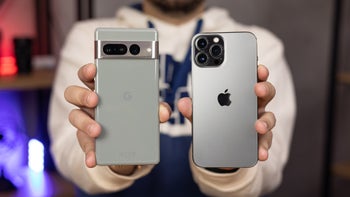
Intro
After the arrival of the iPhone 15 Pro Max and the iPhone 14 Pro Max, the iPhone 13 Pro Max is no longer the best iPhone Apple sells. However, it's still a rather adept device that boasts superb performance, industry-leading battery life, and a versatile camera giving us more than commendable image quality.
In the meantime, Google's latest flagship phone, the Google Pixel 7 Pro, brings multiple improvements in key areas, such as performance, camera, and battery optimization, which make it an excellent follow-up to the previous Pixel 6 Pro. But are those enough to beat Apple's older 2021 flagship?
Surely, both phones are now substituted by newer successors. In the case of Google, we have the Pixel 8 Pro and the Pixel 8, while the iPhone 13 Pro Max has been outperformed by not one, but two generations––the iPhone 14 Pro Max and the iPhone 15 Pro Max.
This is a tricky question. Starting with the Pixel 6 series, Google has seemingly dropped out of the raw performance race and focuses on the user experience instead. The Pixel 7 Pro is the latest proof of that, as it's a phone that relies on brain rather than brawn.
Apple iPhone 13 Pro Max vs Google Pixel 7 Pro in a nutshell:
- Apple A15 Bionic vs Google Tensor 2
- 6.7" 10-120Hz OLED vs 6.7" 1-120Hz OLED
- iOS 17 vs Android 14
- 12MP vs 50MP camera
- 3X vs 5X zoom
- 4352mAh vs 5000mAh battery
Table of Contents:
Design and Display Quality
Apple's Best of 2021 faces Google's Top 2022 flagship

In terms of design, the Pixel 7 Pro and the iPhone 13 Pro Max two are quite different. Apple has been pushing with its flat and posh design for a few generations now, culminating with the iPhone 13 Pro Max. We have a stainless steel frame with glass up front and back, as well as an imposing square-shaped camera island. For peace of mind, the phone has IP68 water and dust resistance, the front utilizes Apple's Ceramic Shield or extra-tough glass, and the camera lenses on the back are made of super-resistant sapphire.
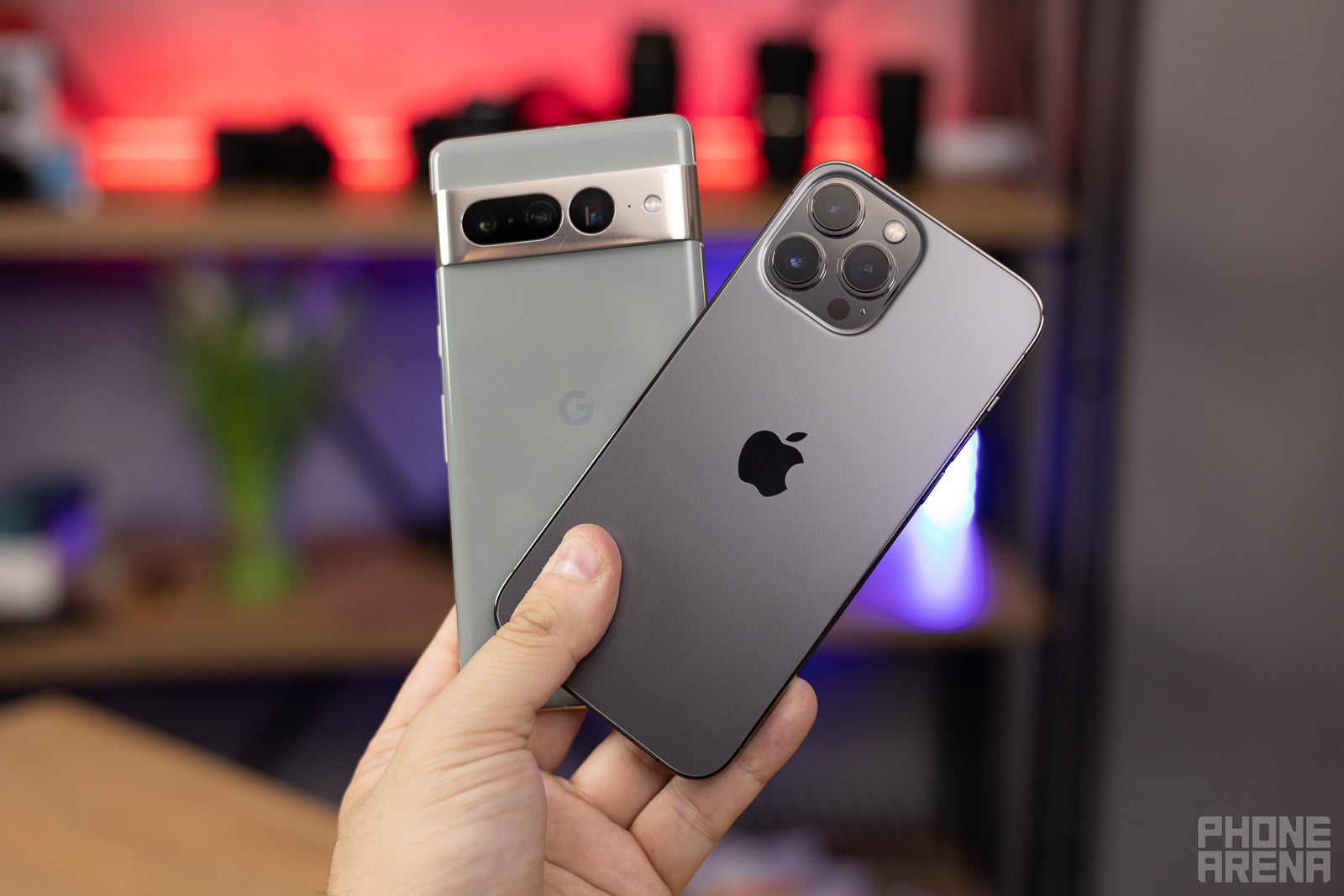
At the same time, the Pixel 7 Pro is mostly similar to its predecessor, with a slightly curved display up front, with a protruding camera strip at the back that's housing all the cameras. The camera strip at the rear of the Pixel 7 Pro is painted in the color of the side frame and isn't stealthy black (as on the Pixel 6 series), giving us a distinct design choice that stands out. However, our particular Pixel 7 Pro unit has already exhibited scuffs and scratches on the rear camera strip, which isn't ideal, and we can only imagine how further wear and tear would affect a case-less Pixel 7 Pro.
On the other hand, an iPhone 13 Pro Max is shamelessly large and heavy, tipping the scales at 240gr, and even more with a case on. It also leaves the impression of being a wider device than most Android flagships, thanks to the dominant use of right angles all around the flat screen and lack of tapered corners. The Pixel 7 Pro has a similar footprint but is noticeably lighter and easier to handle.
Just like the iPhone 13 Pro Max, the Pixel 7 Pro comes with a 6.7-inch display, an OLED one at that. The iPhone 13 Pro Max is the first iPhone to come with a 120Hz LTPO display, allowing it to change its refresh rate between 10 and 120Hz depending on the screen content. The Pixel 6 Pro was the first Google phone to do so, too, and the Pixel 7 Pro improves on that and allows for seamless 1Hz-120Hz switching.
Display Measurements:
Both displays are excellent, with very similar maximum and minimum brightness, contrast, and color reproduction. The Pixel 7 Pro's display is slightly colder, with the iPhone 13 Pro Max nearer to the 6500K display temperature sweet point. Viewing angles on both are great, with a very slight color shift at more extreme angles observed on both.
Performance and Software
Can the Pixel 7 Pro be able to beat the iPhone 13 Pro Max in brawn?
Inside the iPhone 13 Pro Max, one would find the super-fast Apple A15 Bionic chipset, which is still among the top mobile chips out there, even though it was superseded by the Apple A16 Bionic chipset. Its performance could be hardly rivaled by Google's first custom chip, the Google Tensor, which debuted with last year's Pixel 6 Pro flagship, and sadly, the Pixel 7 Pro with its newer Tensor G2 also can't beat Apple's chip.
Our benchmarks test clearly show a significant—and expected—lead for the iPhone 13 Pro Max with its A15 Bionic, and the Pixel 7 Pro trailing it in all kinds of synthetic benchmarks. In real-life usage, however, the difference isn't that stark at all. The Pixel 7 Pro feels just as adept and snappy as the iPhone despite the large performance rift between the two.
Performance Benchmarks:
In terms of memory and storage, the Pixel 7 Pro comes with 12GB of RAM, as well as a starting storage capacity of 128GB. There's a 256 and 512GB versions of the phone. Meanwhile, we've got 6GB of RAM on the iPhone 13 Pro Max, as well as 128GB, 256GB, 512GB, and super-spacious 1TB versions with Apple's top phone.
While that's less than what the Pixel 7 Pro has in store, iOS apps use way less RAM than their Android counterparts, meaning that 6GB of memory is more than enough to ensure a superb experience. And this, paired with the super-fast A15 chip, means that the iPhone 13 Pro Max is truly performing like a champ.
Camera
The iPhone 13 Pro Max is a strong contender, but the Pixel is just better
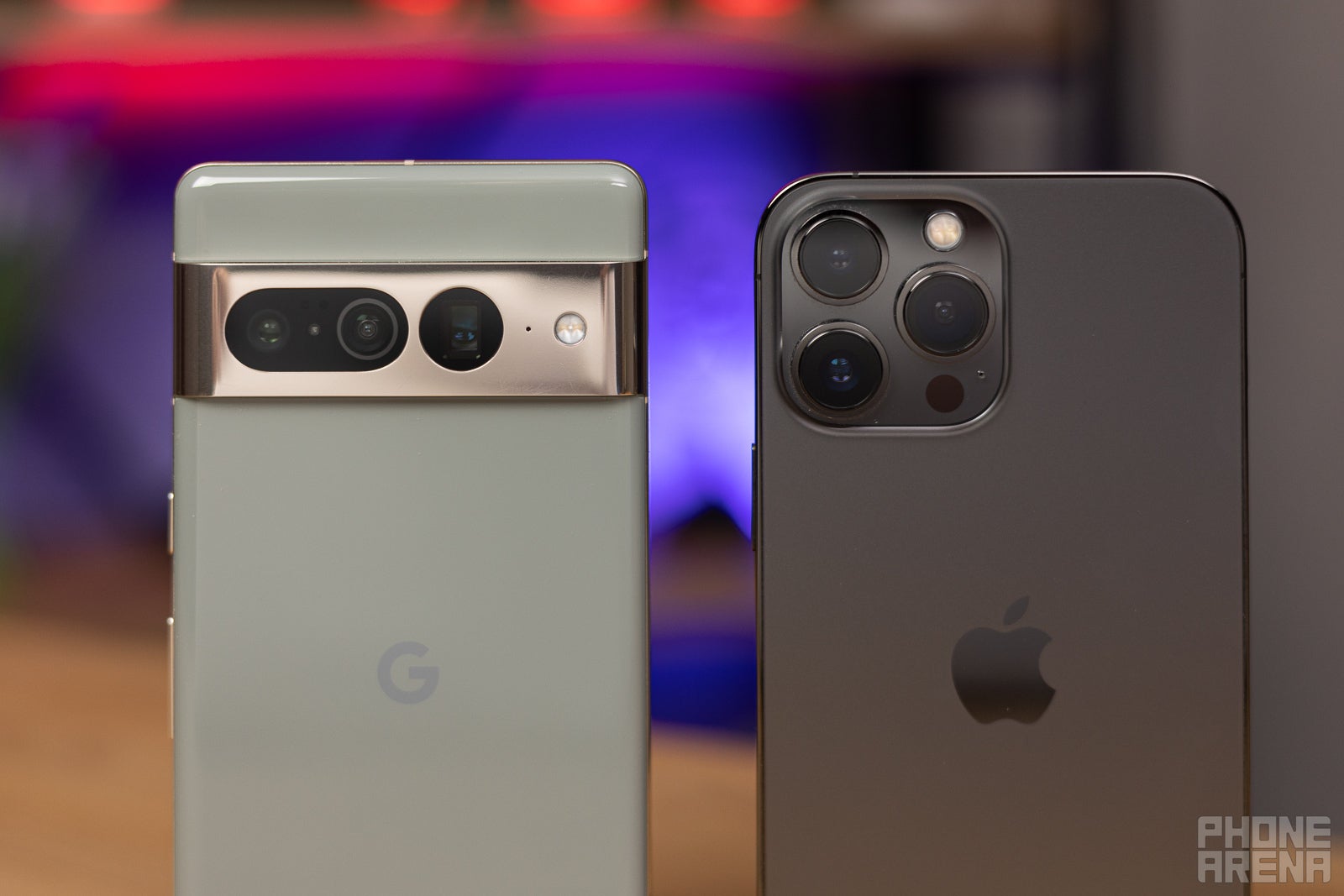
The Pixel 7 Pro camera is mostly similar to the one on the Pixel 6 Pro.
Disappointing, huh? Well, not exactly. Even though the hardware hasn't changed that much, there are tons of improvements under the hood. There's more to the Pixel camera than hardware alone, and those are Google's excellent image processing algorithms, further fueled by the machine-learning and AI capabilities of the Tensor G2 chip. Features like Cinematic Blur, Photo Unblur, improved Skin Tone renditions, and most other software goodies are fully enhanced by the Tensor G2.
The Pixel 7 Pro has the following camera setup:
- Wide-angle: 50MP f/1.85
- Ultra-wide: 12MP f/2.2
- Telephoto: 48MP f/3.5
- Selfie: 11MP
Meanwhile, the iPhone 13 Pro Max uses a new sensor with a wider aperture that's able to capture more light and therefore has a much better low-light performance than its predecessors. Is that enough to trump the new Pixel? We'll find out in a couple of paragraphs. Circling back on the iPhone 13 Pro Max camera loadout, its ultrawide shooter has also received some much-needed improvements and is now more adept in low-light scenarios. It also now supports macro photography, since the iPhone 13 Pro Max can recognize when you are attempting to snap a picture of a close-up subject.
- Wide camera: 12MP 26mm, f/1.5
- Ultrawide camera: 12MP 0.5X, or 13mm, f/1.8
- Zoom camera: 12MP 3X or 77mm (uses digital zoom further on)
- Front camera: 12MP
Image quality
In broad daylight, you can expect similar image quality out of the Pixel 7 Pro and the iPhone 13 Pro Max. The Pixel, similar to many of Google's previous phones, has that slightly dramatic, gritty look that tends to slightly under-saturate your image and have more pronounced contrast, as well as a generally colder image rendition in direct comparison with the iPhone 13 Pro Max.
Apple's former flagship generally produces more "enjoyable" photos, with warmer colors and slightly lifted exposure. On the latter, you can also employ Apple's Camera Styles, which act as default photo filters and allow you to fine-tune the tone and warmth of the camera, so you can easily go for a grittier look, similar to the one on the Pixel. Different strokes for different folks, but overall, both perform more than well in broad daylight conditions.
iPhone 13 Pro Max vs Google Pixel 7 Pro daylight camera samples
iPhone 13 Pro Max vs Google Pixel 7 Pro portrait samples
iPhone 13 Pro Max vs Pixel 7 Pro low-light samples
The low-light image quality of both phones is excellent, with the main difference being the signature image processing of the two cameras. The Pixel 7 Pro tends to boost shadows a bit more than the iPhone 13 Pro Max, giving a more "legible" look, whereas the iPhone 13 Pro Max doesn't expose shadows that well, going for a more distinct night-time look. Bright lights and colors are great on both, but we prefer the Pixel when it comes to low-light shots: it just has better dynamics and exposes the image better. What's more, it doesn't exhibit the same light "splotches" that the iPhone 13 Pro Max tends to deliver sometimes (as evident in the last two scenes in the gallery below).
In terms of video recording, the same adage continues. The iPhone 13 Pro Max produces warmer and slightly better-exposed, mass-appealing videos. The Pixel 7 Pro's video clips are more realistic and grittier, even though this might not fit the bill for that many folks. In terms of video recording capabilities, both can shoot up to 4K footage at up to 60 frames per second. New on the Pixel 7 Pro is 1080p Cinematic Video at 30fps, and lo and behold, the iPhone 13 Pro Max has a similar feature. However, the newer iPhone 14 Pro Max can shoot 4K@30fps cinematic videos, which is a win for the newer iPhone.

Audio Quality and Haptics
The iPhone 13 Pro Max has some of the best and loudest stereo speakers on a phone, with a crisp and deep sound that's a joy to listen to. However, we were also surprised with the Pixel 6 Pro last year, as it had some seriously powerful stereo speakers as well, and true to its roots, the Pixel 7 Pro exhibits a similarly strong and meaty sound. Neither phone has a headphone jack, so you have to go with a pair of wireless earbuds.
Haptics are great on the iPhone 13 Pro Max, strong and exact. The Pixel 7 Pro fares rather nicely in terms of haptic feedback as well, but it seems to lack some of the extra strength that makes the iPhone such a pleasing phone to interact with.
Battery Life and Charging
It is hard to beat the iPhone 13 Pro Max
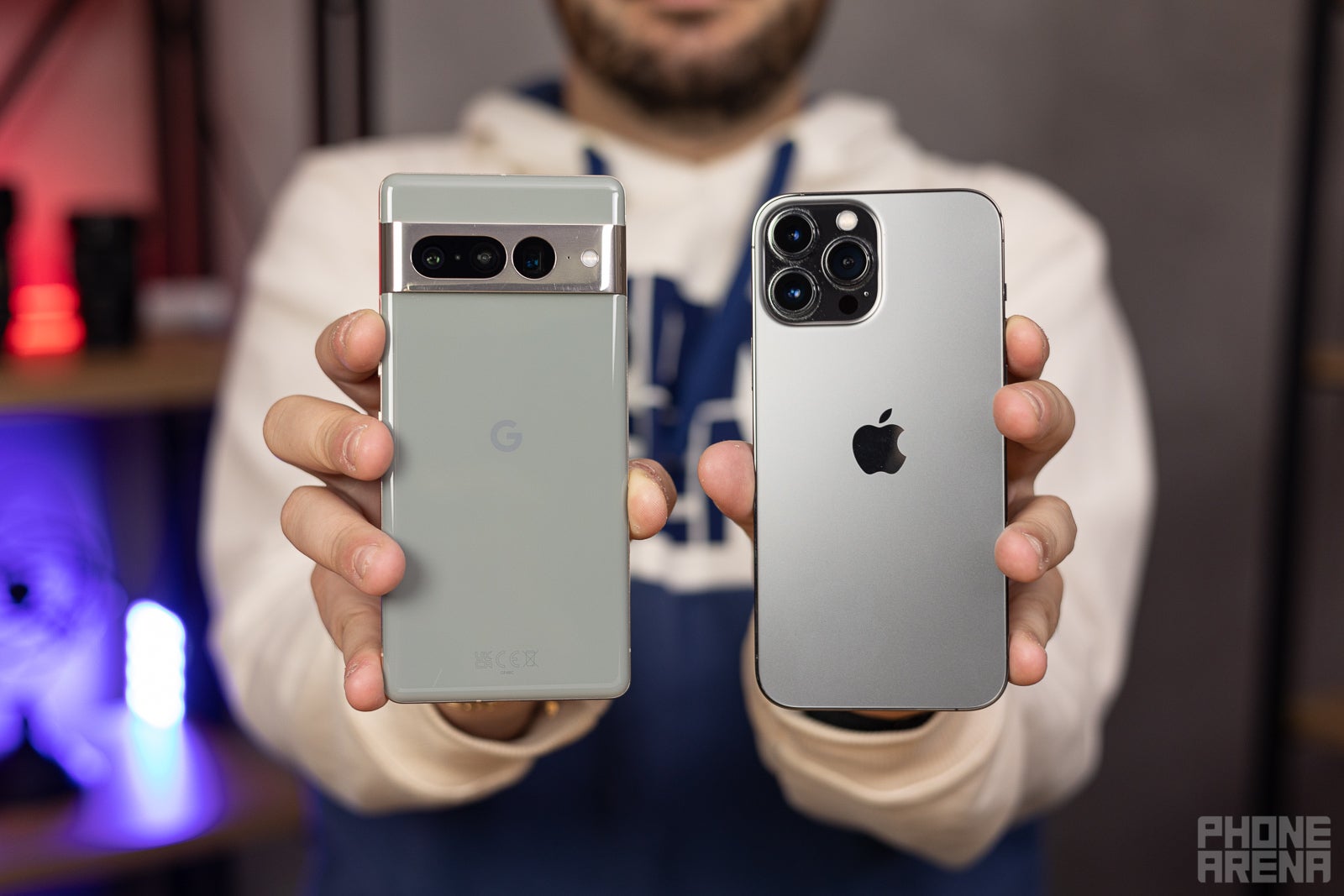
The iPhone 13 Pro Max is a phone that lasts extremely long. Two reasons for that: it has an enormous (for iOS standards) 4,352mAh battery and a super-efficient chipset, the A15 Bionic. Thanks to that, it is easily a two-day phone, and our real-life battery benchmarks confirm that!
Meanwhile, the Pixel 7 Pro has a similar 5,000mAh battery as its predecessor, and thanks to the efficiency improvements in the Tensor chipset, it is a more durable phone than the Pixel 6 Pro. However, it simply can't match the battery life of the iPhone 13 Pro Max, which would last you longer.
Our battery benchmarks, which are executed with the two phones' displays set at a constant brightness level of 200 nits and try to emulate various use cases, generally show that the iPhone 13 Pro Max would last you at least an hour extra during video streaming and more than four hours extra in web browsing. A much bigger difference is observed in our proprietary 3D gaming tests, which have the iPhone 13 Pro Max simply trump the Pixel 7 Pro, and this could be important if you're a gamer.
PhoneArena Battery Test Results:
Support for both wired and wireless 23W charging is found on the Pixel 7 Pro, whereas the iPhone 13 Pro Max supports 20W wired charging and slower MagSafe wireless charging. Due to these similarities, it comes as no surprise that both phones fully charge for roughly the same time - 100 minutes for the iPhone 13 Pro Max and three minutes faster for the Pixel 7 Pro. Take into account that this is a full charge, from 1 to 100%; a top-up to around 80%, which is still perfectly usable, takes around an hour on both phones, after which they're pretty much set for at least a day.
It's important to note that none of the phones come with a stock charger in the box, so you have to get the manufacturer-recommended one if you don't have one already.
Specs Comparison
| Specs | iPhone 13 Pro Max | Google Pixel 7 Pro |
|---|---|---|
| Dimensions | 6.33 x 3.07 x 0.30 inches (160.8 x 78.1 x 7.65 mm) | 6.41 x 3.02 x 0.35 inches (162.9 x 76.6 x 8.9 mm) |
| Weight | 8.47 oz (240.0 g) | 7.48 oz (212.0 g) |
| Screen | 6.7", 1080p, 10-120Hz LTPO OLED, flat | 6.7", 1440p, 1-120HZ OLED, curved |
| Processor | Apple A15 Bionic | Google Tensor 2 |
| RAM | 6GB | 12GB |
| Rear Cameras | Wide camera: 26mm, f/1.5 Ultrawide camera: 0.5X, or 13mm, f/1.8 Zoom camera: 3X or 77mm (uses digital zoom further on) Front camera: 12MP | 50MP wide, f/1.85 12MP ultra-wide, f/2.2 48MP 4X zoom telephoto, f/3.5 |
| Front Camera | 12MP | 10.8MP |
| Battery Size | 4352mAh | 5000mAh |
| Charging Speeds | 20W | 20W |
| Price | Discontinued as of late 2022 $1099 (128GB) $1199 (256GB) $1399 (512GB) $1599 (1024GB) | $899 (128GB) $999 (256GB) |
Summary and Final Verdict
Overall, it's clear as day that the Pixel 7 Pro can't take on the iPhone 13 Pro Max in a pure hardware competition. The second-gen Tensor isn't more powerful than the A15 Bionic, and Apple is in the lead, even when it uses its older horse for the race. If you're one lusting over raw synthetic benchmarks and such, you could very well end up disappointed by the Pixel 7 Pro. Not focusing on raw specs, Google utilizes AI and ML in order to elevate the overall user experience.
Meanwhile, the iPhone 13 Pro Max, as it currently stands, is no longer the top flagship in Apple's portfolio, nor it has the best hardware, but it's still a very, very competent smartphone, which can easily beat a much newer Android flagship in many key areas. For example, it truly shines in terms of raw performance, battery life, and let's not forget its excellent camera versatility and image quality, which are mostly similar to what the Pixel 7 Pro has to offer.
And then comes the pricing difference: the Google Pixel 7 Pro starts at $899 for the entry-level 128GB version, while the iPhone 13 Pro Max was selling for $1,099, which is just as much as the price tag on the new iPhone 14 Pro Max, so it would make sense to go with the newer iPhone instead. Apple has already discontinued the iPhone 13 Pro Max, so your best bet is to find it from a third-party retailer or get it second-hand, but it would definitely make more sense to consider the iPhone 14 Pro Max instead.
Which one to pick? Well, if you have an iPhone 13 Pro Max and are looking to test out the Android waters, the Pixel 7 Pro could be an excellent entry point. The overall experience is pretty similar despite the different ecosystems, and with a few small changes and accommodations, you might quickly find yourself loving Google's latest flagship and the Android ecosystem as a whole.
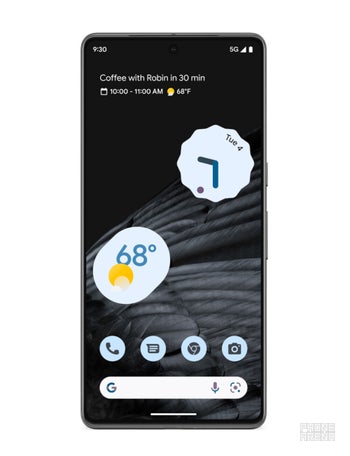
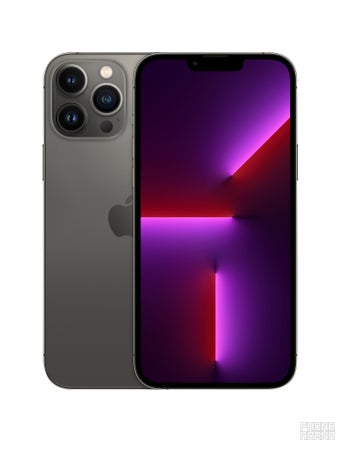






















Things that are NOT allowed: